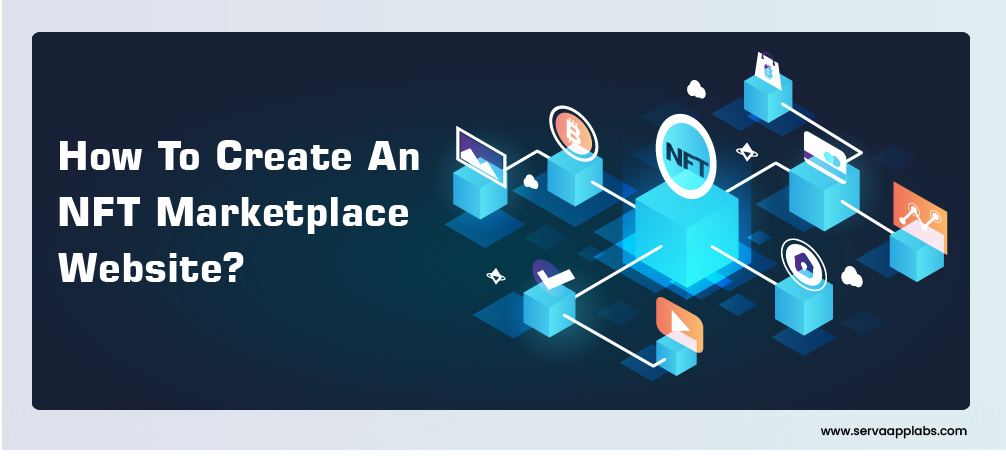Non-fungible token, or NFT marketplace website, is a thriving sector of the crypto economy. According to NonFungible.com, the general capitalization of major NFT projects increased by more than 2,100% in the first quarter of 2021. Many NFT tokens are now being sold instantly, with the most popular fetching more than $70 million.
This guide will go over how to set up a Mobile App Development NFT marketplace. We will go over mapping goals, networks, protocols and standards, budgeting, benefits and key features, and the necessary technology stack for creating the NFT platform, from testing to launch to maintenance, and much more. Let’s get started right away!
What is NFT?
A decentralized NFT marketplace platform allows users to generate, buy, sell, and non-fungible store tokens. They primarily sell specific assets, such as a digital token of artwork, games, soundtracks, or any other form of artistic production, along with information about their ownership and validity.
There are numerous NFT market niches, which include:
Art
These platforms can deliver paintings, 3D models, GIFs, songs, videos, and other forms of digital art.
Video games
Customer accounts, in-game items, and characters are all purchased by customers. NFT marketplaces ensure transaction security. Essentially, users can purchase in-game tokens in order to resell them at a higher price and earn money.
E-learning
NFT marketplace apps can offer online education services such as courses, lectures, and training programs from corporations, individuals, and universities.
Investment
NFT investment marketplaces facilitate asset trading (shares, bonds, exchange-traded funds, property rights, and so on) as well as a cryptocurrency exchange.
NFT Market Website Features
Inseparable
It is not possible to divide NFTs into smaller amounts or to buy or transfer a portion of them.
Uniqueness
Each NFT has a distinct feature that is frequently recorded in token data. NFTs all have different persons, and they are not the same.
Ownership
These tokens guarantee ownership of the transferred asset.
Shortage
The scarcity of NFTs is one of the factors driving up their value. Developers can create as many assets as they want, but they can also limit the number of NFTs to create scarcity.
Interoperability
NFTs can be exchanged, acquired, or sold across multiple DLTs using a decentralized bridge or centralized custodian service.
Transparency
Buyers can trust and verify the validity of a specific NFT because public distributed ledgers are decentralized and immutable, with public records of token issuance, transfer, and activity.
The Most Important Advantages of NFTs
Originality
The rarity of non-fungible tokens determines their advantages. NFTs are created on the blockchain, which means they are linked to unique data. The characteristics of NFTs indicate their ability to add value. Simultaneously, NFT manufacturers can release a limited number of NFTs to create supply scarcity.
Ownership
The ability to prove ownership is the primary benefit of non-fungible tokens. NFTs can help connect ownership to a single account because they operate on a blockchain network.
So, there are NFTs How To Create An NFT Marketplace Website? that are also non-distributable, which means they cannot be shared among multiple owners. At the same time, the advantages of NFT ownership keep customers from purchasing counterfeit NFTs.
Transferability
Because NFTs are based on stylish contracts, their use clarifies ownership transfers. Before ownership moves, smart contracts set up certain conditions between the buyer and seller that must be contented.
Therefore there are many benefits to the NFT marketplace. All factor includes in the NFT marketplace.
How Does an NFT Marketplace Work?
Generally, all NFT marketplace websites adhere to the same procedure. To begin, a user must register on the website and download a digital wallet to store their NFTs. Following that, users can create assets by uploading items to showcase their work. The user can also select which payment tokens to accept for their artwork and, if the platform recommends it, set a fee.
The next step in the process is to list the goods for sale on the market. The user gets the chance of a secure-price bid in an auction. When a user lists an item for sale, a transaction is initiated to kick off a personal trade smart contract in the user’s wallet. Collection moderation may be required for the platform, and NFTs will be added to the list once they have been approved.
NFT Marketplace Back-end
- Blockchain: Ethereum, Binance Smart Chain.
- Token Standard: ERC721, ERC1155, BEP-721, BEP-1155.
- Smart contracts: Ethereum, BSC Virtual Machine, Virtual Machine.
- Frameworks: Spring, Symfony, Flask.
- Programming languages: Java, PHP, Python.
- Databases SQL: MySQL, PostgreSQL, MariaDB, MS SQL, Oracle.
- Databases NoSQL: MongoDB, Kassandra, DynamoDB.
- Search engines: Apache Solr, Elasticsearch.
- DevOps: GitLab CI, TeamCity, GoCD Jenkins, WS CodeBuild, Terraform.
- Cache: Redis, Memcached.
Final Word
Overall, we believe that the NFT marketplace website is an excellent and profitable market for all designers, crypto enthusiasts, and business owners. We only ask that you stay focused, make educated decisions, and be consistent, because any new platform, and especially designers, may take time to succeed.
It should be much easier to make decisions after establishing how to make your own NFT marketplace and considering all the details regarding the mapping of goals, networks, protocols, and standards, budgeting, benefits, and key features, the necessary technology stack on how to create a marketplace, testing, launch, and maintenance, the most valuable aspects of the development process, and much more.




